On 26 September 1991, with all the pomp of a NASA shuttle launch, eight bionauts in boiler suits stepped into a spacecraft in Oracle, Arizona. Discover, the popular science magazine, declared the mission ‘the most exciting venture to be undertaken in the US since President Kennedy launched us to the moon’. However, the crowds who had assembled didn’t witness any blast-off. The bionauts were going nowhere – for two whole years. Their hermetically sealed glass vivarium was an environmental laboratory and prototype for a self-sufficient space colony; they were to test if people could survive in this portable world that might one day be transplanted to another planet.
The three-acre structure had echoes of Crystal Palace and Buckminster Fuller’s geodesic dome for Expo 67. The creators of this tiny planet, named Biosphere 2 (number one being Earth), travelled the world sourcing species for their greenhouse ark or hi-tech Eden. The vaulted space frame structure contained a miniature ocean, with coral reef, an area of desert, a grassland savannah, mangrove wetland and rainforest. Matt Wolf’s intriguing and inspiring documentary film about the project takes its title from Fuller’s book Operating Manual for Spaceship Earth (1969), which imagined Earth as a spaceship flying through the galaxy with finite resources. Their endeavour was much documented from both without and within (even calls with team members’ therapists were recorded), providing Wolf with a rich archive that is skilfully edited together with contemporary interviews with the protagonists.
The originators of this earthbound contribution to the space race were not scientists, but members of an avant-garde theatre troupe who lived together in a commune at Synergia Ranch in New Mexico. Synergia was run according to Wilhelm Reich’s anarchic philosophy of ‘work democracy’ and had a geodesic dome for a rehearsal space. The company met in San Francisco in the late 1960s, where they founded the Theater of All Possibilities, and travelled to New Mexico in a Ken Kesey-like school bus. Though they were interested in exploring the frontiers of human potential, they didn’t do drugs. There were no chemical barriers to their entrepreneurial ambition and impressive work ethic.
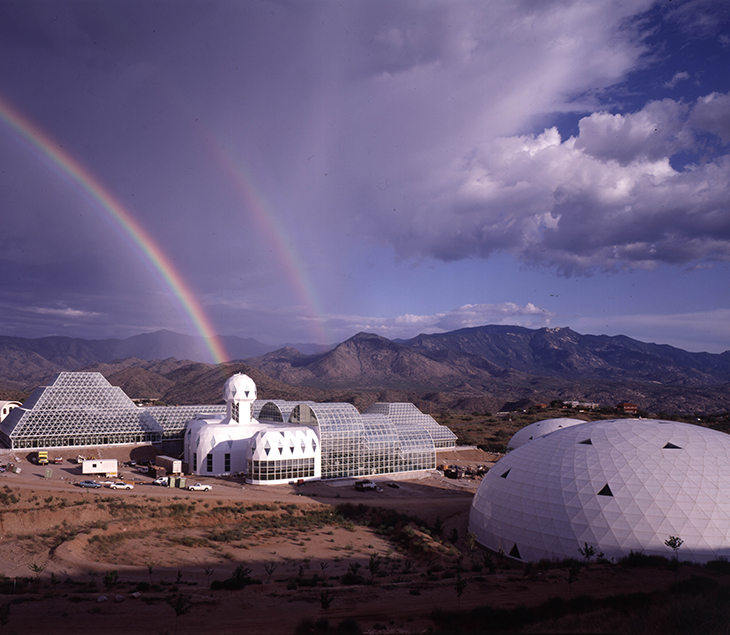
Exterior of Biosphere 2. Courtesy NEON
Their leader, John Allen, was a former engineer in the army with an MBA from Harvard. With oil money provided by Ed Bass, the rebellious scion of the fourth wealthiest family in America, they travelled the world in a boat named Heraclitus, which they’d built themselves, performing plays in every continent, including Antarctica. As they toured the globe, they started green-washing projects along the way, funded by Bass and designed as ‘engines of change’: they bought a swathe of rainforest in Puerto Rico, constructed a hotel in Kathmandu, and in 1979 Allen co-founded the October Gallery in London to promote the trans-cultural avant-garde.
Biosphere 2 was another manifestation of their buccaneering belief in blurring the boundaries between art, theatre and sustainable, environmentally conscious economics. If the voyages of Heraclitus had been influenced by earlier adventurers like Thor Heyerdahl and his Kon-Tiki expedition, Biosphere 2 was pure science fiction, reflecting the group’s growing environmental concern. This lifeboat for earth was inspired by films such as Silent Running (1972), which depicted a post-apocalyptic capsule of the planet. Its resident architect, Phil Hawes, had originally proposed a 110-foot flying space doughnut in which plants could be cultivated and miniature farm animals kept, along with a back-up hard drive of cryogenically frozen seeds for 20,000 other species. The resulting glass castle in the Arizona desert, a terrestrial version of this space fantasy, cost Bass $200 million.
Before their much-anticipated ‘launch’, the theatrical commune staged a play, The Wrong Stuff, which showed all the things that might malfunction in their experiment. The production resembled something between Judith Malina and Julian Beck’s Living Theatre and a Bauhaus pantomime. The performance ended with the players kneeling in a row on stage, taking final gulps of oxygen-starved air, before tumbling like dominoes. The real media event was similarly carefully scripted, involving the delivery of stilted lines like: ‘the experimenters have entered the experiment’. It went off to an inauspicious start when the airlock door of the Biosphere wouldn’t close.
As we’ve all recently become exiles in our own countries due to the pandemic, and experienced the struggles and tensions of living with others under house arrest, Matt Wolf’s film is a timely metaphor for lockdown. Perhaps because of this, I longed for more on the dynamics and internal drama between the crew stuck in their Truman Show bubble, with 160,000 paying visitors coming to stare at them through the glass in the first six months, including William Burroughs and Timothy Leary. The Biosphere project was acknowledged by Big Brother as a precursor, with 15 contenders whittled down, through a gruelling programme of theatrical improvisation, to eight successful candidates whom Allen judged to be ‘freethinkers’.
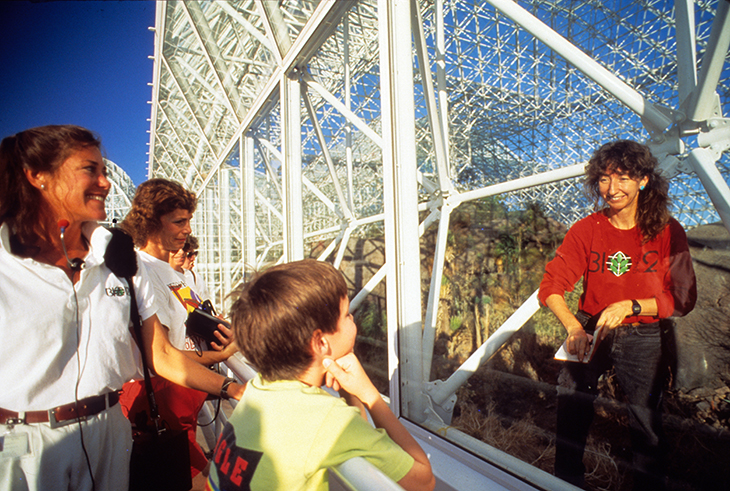
Biospherian Linda Leigh and tourists. Courtesy NEON
In one scene of archive footage two bionauts are spied by tourists through the glass as they wrestle in the mud, but otherwise, apart from the odd hissy fit and thrown-down rake, as these freethinkers argued over chores, life inside looked relatively harmonious. All anger seemed to be projected on to Allen, who directed the actors, and the overall theatre, from Mission Control, a small cabin backstage. I’ve read in one memoir that in reality things inside were more tense: as food and oxygen levels got perilously low, the irritable team splintered into two opposing factions who hardly spoke to each other. After disappointing crop yields, food was stolen and the stores had to be locked and carefully rationed. The resident doctor, a gerontologist named Roy Walford, at 69 the oldest member of the team, put them on a ‘calorie restriction with optimum nutrition regime’ that he thought was the secret to long life and which he described in his book The 120-year Diet (1986).
After one of the team had to leave the Biosphere to undergo surgery, having chopped off the tip of her finger in a threshing machine, the walls of this Eden began to fall. She was seen sneaking back in with two duffle bags of extra supplies, and accusations of cheating and fraud began to circulate in the media. Allen, who was becoming increasingly paranoid and secretive, was portrayed as a brainwashing cult leader, the ringmaster of strange rituals at Synergia. When the bionauts began to asphixiate due to high CO2 levels (12 times that of the outside), extra oxygen had to be pumped in to their dome, invalidating the purity of the experiment. Despite subsequent attempts to scratch together an advisory board of distinguished scientific experts, most academics dismissed the project as environmental entertainment rather than research. Time magazine judged it among the worst ideas of the 20th century.
On 1 April 1994, six months after the first cohort of bionauts emerged into fresh air, a helicopter arrived, and Allen and his senior team were marched off the premises, accused of financial mismanagement. Steve Bannon, then a banker, was installed as CEO. The April Fool’s joke was that he didn’t believe in climate change. A second team of bionauts opened doors and broke seals, acts of sabotage in protest at his appointment. Wolf resists the temptation to use Bannon to tie his film neatly to Trump and to our perilous moment in the battle against climate change. He gives Allen and his optimistic friends the last word. The Sixties commune, unlike so many others, didn’t disintegrate, and Allen and many of his troupe still live together in old age on Synergia ranch, where their utopian dreams and performative brand of environmental activism all started.
Unlimited access from just $16 every 3 months
Subscribe to get unlimited and exclusive access to the top art stories, interviews and exhibition reviews.

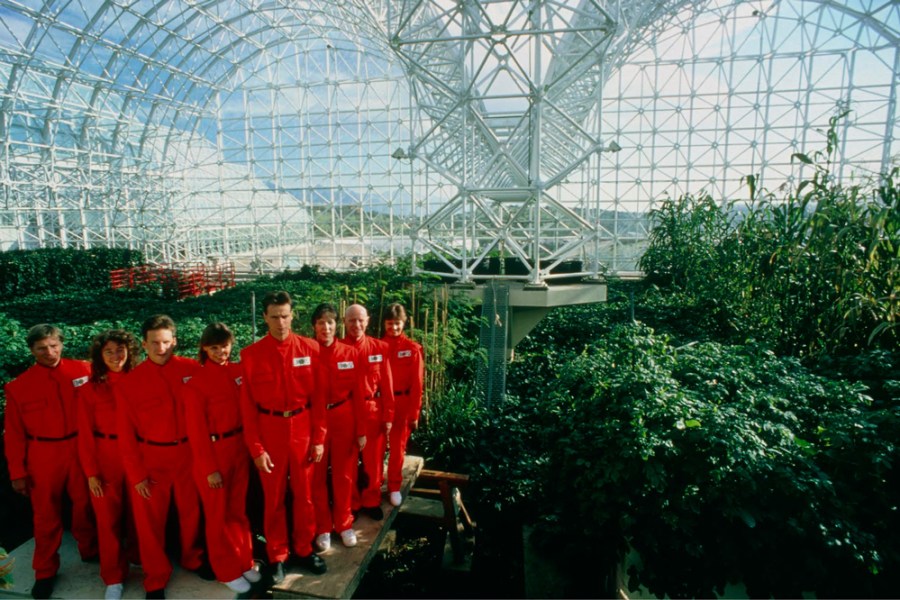
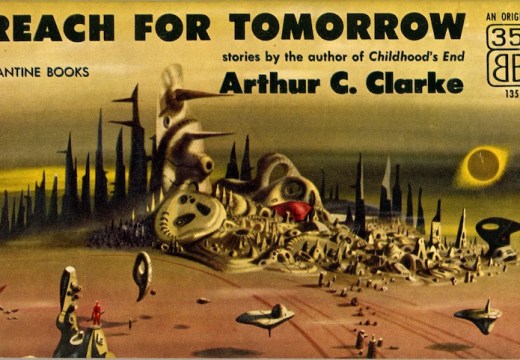
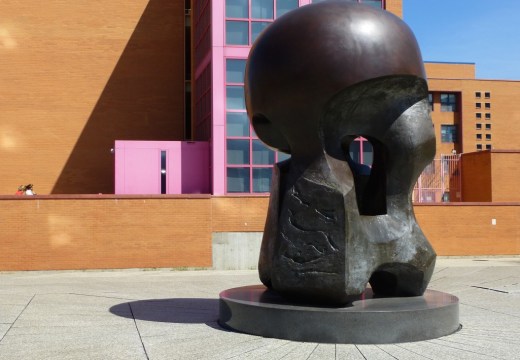
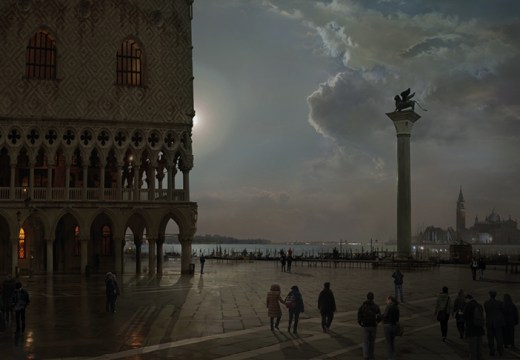









![Masterpiece [Re]discovery 2022. Photo: Ben Fisher Photography, courtesy of Masterpiece London](http://www.apollo-magazine.com/wp-content/uploads/2022/07/MPL2022_4263.jpg)
It’s time for the government of London to return to its rightful home